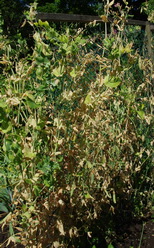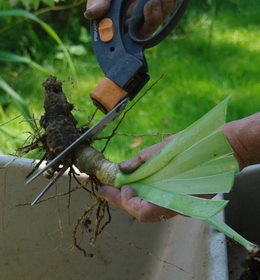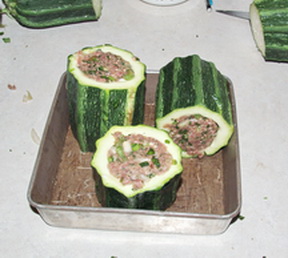


We had several weeks with no rain and the biggest crop in the garden was toasted Peas. Returning from a week’s holiday in Corner Brook, Newfoundland, I quickly decided that trying to keep the whole place watered was not a viable option. Put the sprinkler on the main vegetable section, hoping to avoid having any other pre-toasted vegetables. Went to bed and sat up with a start, remembering that the sprinkler was still on and had been running for about 4 hours, providing a nice deep watering to that section of the garden. Woke up the next morning to a thunder storm that supplied almost 3/4 inch of rain. Later that morning the mail lady delivered the card that I use to read the water meter. Sometimes things just happen in life.  In as cool a spot as I can find the freshly seeded trays of fall vegetables such as Broccoli, Kohl Rabi and Bok Choi are growing nicely. There are also several varieties of lettuce germinating that will keep us in cool salads during the late summer. I can just stick these plants in wherever I pull out the toasted Pea plants and other early veg.
In as cool a spot as I can find the freshly seeded trays of fall vegetables such as Broccoli, Kohl Rabi and Bok Choi are growing nicely. There are also several varieties of lettuce germinating that will keep us in cool salads during the late summer. I can just stick these plants in wherever I pull out the toasted Pea plants and other early veg.  The well established and deeply planted Lilies have grown quite well in these conditions. Unfortunately many of them have managed to bloom during the hottest days and the blooms only last a few days before they succumb to the heat. The few red lily bugs that I apparently missed, as adults, have successfully laid some eggs and the larva are making nice holes in the leaves that at least indicate where to look for them. I’ll now go around the garden as the blooms fade and remove the spent flowers heads to prevent seed development. The plant’s energy that would go into developing seeds is better spent regenerating the Lily’s bulbs. The picture here was taken just outside my back door one evening when the sun was setting but illuminating this group of Lilies and nothing else; makes all the red lily bug chasing worth the effort. The always tough Daylilies, (Hemerocallis spp.) are blooming prolifically but I do see that the blooms are noticeably smaller this year. Maybe yesterday’s rain will have some effect on them.
The well established and deeply planted Lilies have grown quite well in these conditions. Unfortunately many of them have managed to bloom during the hottest days and the blooms only last a few days before they succumb to the heat. The few red lily bugs that I apparently missed, as adults, have successfully laid some eggs and the larva are making nice holes in the leaves that at least indicate where to look for them. I’ll now go around the garden as the blooms fade and remove the spent flowers heads to prevent seed development. The plant’s energy that would go into developing seeds is better spent regenerating the Lily’s bulbs. The picture here was taken just outside my back door one evening when the sun was setting but illuminating this group of Lilies and nothing else; makes all the red lily bug chasing worth the effort. The always tough Daylilies, (Hemerocallis spp.) are blooming prolifically but I do see that the blooms are noticeably smaller this year. Maybe yesterday’s rain will have some effect on them.  It is approaching the end of July and that indicates the time of year to start digging and dividing the Iris. Look for large clumps that have most of their leaf fans on the outside of the clump, leaving a bunch of old rhizomes in the centre. Dig the clump and look for any evidence of the Iris borer and then divide and replant. A good sized, healthy, division should give at least one bloom stalk next year. I tend to do this to mine every 4 - 5 years, depending on how quickly they grow.
It is approaching the end of July and that indicates the time of year to start digging and dividing the Iris. Look for large clumps that have most of their leaf fans on the outside of the clump, leaving a bunch of old rhizomes in the centre. Dig the clump and look for any evidence of the Iris borer and then divide and replant. A good sized, healthy, division should give at least one bloom stalk next year. I tend to do this to mine every 4 - 5 years, depending on how quickly they grow. The Clematis that I have been carefully training up through the branches of the Crab Apple tree has finally rewarded me with a mass of purple blooms covering the branches of that Crab Apple. The best Clematis types to train in this way are the mid summer blooming ones that tend to bloom on the current year’s growth. This gives them an opportunity to grow a considerable distance among the branches before they bloom and they will be sure to bloom long after the tree itself has finished blooming.
The Clematis that I have been carefully training up through the branches of the Crab Apple tree has finally rewarded me with a mass of purple blooms covering the branches of that Crab Apple. The best Clematis types to train in this way are the mid summer blooming ones that tend to bloom on the current year’s growth. This gives them an opportunity to grow a considerable distance among the branches before they bloom and they will be sure to bloom long after the tree itself has finished blooming.Time to answer a few questions and then get back into the garden. If you have a gardening question just ‘reply’ to this newsletter and send me your query. I try to answer most of the questions and the ones that I answer here are those that I think will have the widest interest. You can also find the latest garden updates on the front page of gardening-enjoyed . Genepher Responds ? Good morning Ken Have just been enjoying the latest Dallying. Two good pruning books give instructions for both "topiary" and "standards" pruning and may help 'Judie': The Pruning Book by Lee Reich published by the Taunton Press Cavendish Encyclopedia of Pruning and Training by Christopher Brickell and David Joyce published by Cavendish Books, Vancouver. I always look for such books in the library before deciding to buy but guess they may be available thru the net. Ken Answers? Thanks Genepher, gardeners are always a great help to each other. Ann Asks ? Last week I was at the farmer's market near the Hydro plant in Ajax and fresh garlic was available. It was a good size. When I mentioned to them how early their garlic harvest was the woman said that once they trim the seed heads they leave the plant for just a week or so and pick the garlic. I rushed home and dug up 2 garlic plants and they were just a medium size bulb ( and so was their's). Should I not wait until the plant browns before harvesting and ultimately ending up with a larger bulb (and more fragrant)? Ken Answers! I suspect they dig theirs a little earlier than most of us so that they can have the earliest garlic at the market. Early crops always command a premium price. I dig most of mine much later, probably because I’m a natural procrastinator. Once there are no fresh scapes left to add to my cooking I may dig the odd bulb just to get some Garlic for dinner. April’s Helpful Hint. I must say i really enjoy your news letters, i find them very interesting and look forward to reading them. I work at a lily farm in Vasey ont. And i couldn’t help but read about the little red pest lol. I have a recipe i would like to share with you and your readers. What i do is spray this under the leaves to kill the larva , then it eventually gets rid of the beetle. It works good for me and i have had some of the customers say it is amazing stuff. All you need 6- cloves of garlic, 1 medium onion, 1 tbs of cayenne pepper, and 1 tsp of dish soap add to 1 quart of water . Let set in covered container for 48 hours. (outside would be best as for it will smell up your house) stain in to spray bottle. Throw discarded waste around flower beds to rid of slugs and snails . Ken Answers! More helpful advice from my readers. Thanks April. I have seen a few versions of this spray and it does seem to work but its action is probably contact and must hit he beasts to be effective. 111 Trent St. W. Whitby ON L1N1L9 |
 It is amazing how well some of the native vegetation (aka weeds,) can thrive and grow while the vegetables turn crispy brown. Many of the veggies, especially the vine crops actually were flourishing in the heat and dry. I noticed a tiny
It is amazing how well some of the native vegetation (aka weeds,) can thrive and grow while the vegetables turn crispy brown. Many of the veggies, especially the vine crops actually were flourishing in the heat and dry. I noticed a tiny 